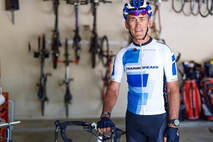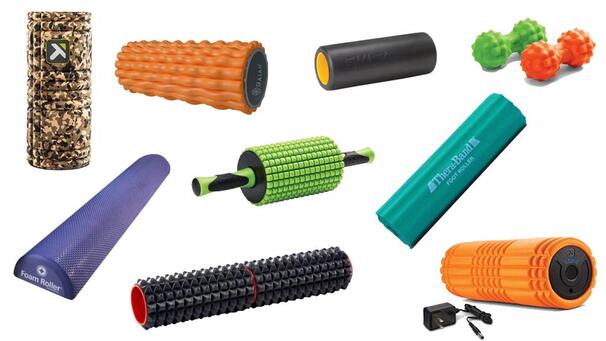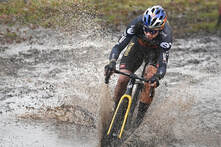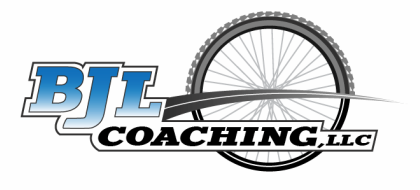 The Godfather of endurance coaching and author of the Training Bibles, Joe Friel, recently wrote a whole book, called Ride Inside, on indoor training. Indoor training has become increasingly popular, and with the interactive platforms such as Zwift and RGT, and the more "realistic" equipment available, riders are logging more hours indoors. Some athletes are actually dedicated and sponsored indoor racers! Being forced inside during 2020 certainly added fuel to this fire. Riding indoors has it's own set of challenges. Last week, I wrote about Cardiovascular Drift, which is not uncommon during indoor training due to increasing body temperature and dehydration. There are steps you can take to help avoid this as well as more considerations about your setup. Here's a great article by Joe Friel that was posted on the TrainingPeaks Blog about setting up your indoor training area: Making Your Indoor Cycling Setup Work for You https://www.trainingpeaks.com/blog/making-your-indoor-cycling-setup-work-for-you/ If you don't have a dedicated smart bike, if you have a second bike that you can leave on your trainer, I find this eliminates one of the barriers that often exists for athletes. Little things like that can really help to make sure you get on your bike for your workout. It doesn't need to be fancy, but with a little thought, a couple of box fans, a little entertainment, and plenty of fluids, you can have a much more enjoyable time. To sign up for my remote indoor training classes, click here: Remote Indoor Training Classes If you want to get more out of your indoor AND outdoor training, I offer customized training programs that will upload to all popular training platforms and head units. If you're interested in setting yourself up for your best year ever, drop me a line. Email Coach Brian Coach Brian
0 Comments
 Why is my power staying steady, yet my heart rate continues to climb? Most of us have experienced this first hand. This is known as cardiovascular drift or heart rate decoupling. But why does it happen? Should we care? If so, what can we do to help mitigate it? Although some athletes may interpret this higher heart rate as getting a better workout, according to Dr. Ed Coyle of the University of Texas, this extra stress is not beneficial It is a negative type of stress. Take a look at the graph from one of my athletes doing some long (15 minute) sweet spot intervals: Key: Red: HR in BPM; Purple/Pink: Power in Watts; Blue: Target Intensity in Watts For each interval the power was very steady as you can see, but their heart rate rose over each successive effort. By the numbers, interval #1 was a 144 average HR, #2 was 151, and #3 was 155. An 11 BPM jump from the first to the last. Part is due to fatigue, but this workout was done indoors and heat played an issue. That's a great graphical example of what cardiovascular drift looks like using data. So what's the deal?  Foam Rolling There are so many different techniques out there for recovery. Which ones work and which ones are the proverbial snake oil? Foam rollers are tried and true tools that many athletes, coaches, and therapists believe in, but do they actually work? Is it a viable alternative to a massage? The first time I ever saw a foam roller was in 2007 during a stage race. I was hanging out with a fellow racer after a stage and he busted one out. He was a physical therapist and did a great job explaining what it was all about and showed me some exercises. I tried it and darn near cried as I attempted to roll some areas of my very sore legs. He helped me with my technique and assured me I would get better at it with practice. Shortly after, my chiropractor gave me one to use on my “trouble areas.” While there are times that I need to be more consistent with my foam rolling, I’ve stuck with it since then for the most part and find it very beneficial. I’ve learned to make it into a “good” hurt, now able to control how deep I make the massage. Here are five resources I found that I thought would be beneficial as related to foam rolling. First, this article on Cycling Weekly really covers the concept of myofascial release and foam rolling from soup to nuts: Foam Rollers Positive Effect Second, an article on TrainingPeaks that talks about why, when and how: Why, when, and how to use a foam roller Next, a graphic of some of the most common exercises by the same author: Exercises Fourth, a healthy discussion on the TrainerRoad podcast: Trainer Road And finally, the most “sciencey” of them all, an in depth look by Dylan Johnson: Dylan Johnson If you’re interested in giving it a try, make sure you educate yourself and seek out the guidance of a professional to teach you the exercises. You can then form your own opinion. Start slowly but stick with it. Hopefully you find it beneficial as well! Do you foam roll? What other forms of myofascial release to you employ? Leave a comment or question below! While rest is best, some recovery is indeed active. Roll with purpose! Coach Brian  If you’re reading this, there’s a very good chance that you’ve pushed yourself athletically at some point in your life. Quite likely, this could describe you very recently. During that pursuit of athletic progression, you’ve probably had some great days, some good days, and some downright crappy days. Rest assured, this is quite normal and expected. However, the distribution of these days should be considered. When Olympic athlete Alexi Pappas was preparing for the Rio Olympics and experiencing a difficult period of training, her coach told her: “When you're chasing a big goal, you're supposed to feel good a third of the time, okay a third of the time, and crappy a third of the time...and if the ratio is roughly in that range, then you're doing fine.” It might seem a bit pretentious to compare yourself to an Olympic athlete, but goals are goals and pushing yourself to your own personal limits can be comparable. We must be careful what training advice we take from professional athletes and their coaches, however this is invaluable wisdom. If you’re probing the edge of your limits, expect to periodically feel less than awesome. Likewise, if you always feel incredible and can easily crush every workout, perhaps you’re leaving a little on the table. On flip side, if you’re usually beat down and regularly feeling like you got kicked in the teeth, I would say that’s a pretty good indicator that it’s time to dial it down quite a bit. There are so many reasons why an athlete can have a bad day. I heard a coach recount a story of speaking with an athlete after a rough workout . The athlete was trying hard to pinpoint what the issue was. This is indeed important reflection, but sometimes the answer really is “it was just a bad day.” The coach asked the athlete if they ever had a bad day at work. They replied, “of course!” Just like we can all unfortunately experience those “bad” days of our lives, we can expect the same during training. We all just need to be mindful and make sure we’re have as many decent and incredible days as those days when we are feeling sub-par. Please understand that I’m not talking about if you’re injured or sick or toeing the line of pushing too hard. Examples of this could be identified as non-functional over reaching, or worse). This bottom third are those days when you’re feeling “off”, tired, maybe a little unmotivated, or just don’t feel good on your bike. Experience will help you distinguish between the bad bad days and the not so bad bad days. When in doubt, it’s best to be conservative and rest. A qualified coach can help you to learn which is which and assist in making informed decisions on how to proceed. Here are a couple of quick reads as well as a video with Alexi: Rule of Thirds Connor Swenson https://www.connorswenson.com/blog/rule-of-thirds#:~:text=%E2%80%8D%E2%80%9CWhen%20you're%20chasing,you're%20doing%20fine.%E2%80%9D Rule of Thirds in People Matters https://www.peoplematters.in/article/sports-books-movies/rule-of-thirds-30060 Alexi Pappas Video https://www.facebook.com/richrollfans/videos/the-rule-of-thirds/1052734018566507/ So keeping pushing the edges while weaving in those easy days as well as full rest. Give yourself permission to have those bad days and be OK with them. Don't let those bad days or workouts bring you down. Take the good with the bad, along with the middle. The rule of thirds is a good one! Cheers, Coach Brian  Embrocation. Warming Gel. Balm. Belgian knee warmers. That wonderful smell the fills the air at a ‘cross race. It doesn’t even need to be that cold outside, and you’ll see racers lathering up their legs with all makes of concoctions. Back in the day, we called it sports cream and locker rooms were ripe with the smell of menthol, and perhaps a bit of b.o. for good measure. Embrocation is typically applied pre-activity as opposed to being used as pain relief for post-activity. I’ve used warming creams and gels for other cool races beyond cyclocross. Does it actually work? With the right product, you’ll definitely feel a warming effect, although sometimes it’s far warmer in the shower hours after the application than actually during the race. There are other additives that can help such as a gel that helps repel water and mud on those cold and wet races. But actually keep you warm and help your performance? Well that’s where the science falls short. There are some downsides with embrocation and precautions that must be taken. First and foremost is understanding that although you may feel warm, you’re not actually protecting your muscles and joints from cold. Or even worse, your skin, if the temps drop into frost bite zone. So we actually trick our mind that our legs feel warm, so they must be OK. They might not be as the studies showed in the podcast I referenced a few weeks ago. See: September 20--Tip of the Week In my estimation, that’s the greatest concern. Second would definitely be being mindful of your hands after applying the warming cream. You don’t want to itching your eyes or dealing with contact lenses with any trace of embro on your fingers. Chamois cream application can certainly get uncomfortable, too. Eating with your fingers could be downright dangerous. So keep in mind the order of things and make sure you are able to get the embro off your hands before moving on. This article lists some great “rules” for carefully and successfully dealing with embrocation: https://cyclingmagazine.ca/spotlight/8-embrocation-mistakes-absolutely-dont-want-make/ So if you reach for the embro before those cold races and rides, keep these things in mind. And remember, that the warming cream does not take place of covering your legs or a warm-up. Take care of yourself and enjoy the cold rides! Coach Brian |
Categories
All
Coach B.L.Coach B.L. is the head coach at BJL Coaching and an avid racer and cycling enthusiast himself. Archives
July 2024
|

 RSS Feed
RSS Feed